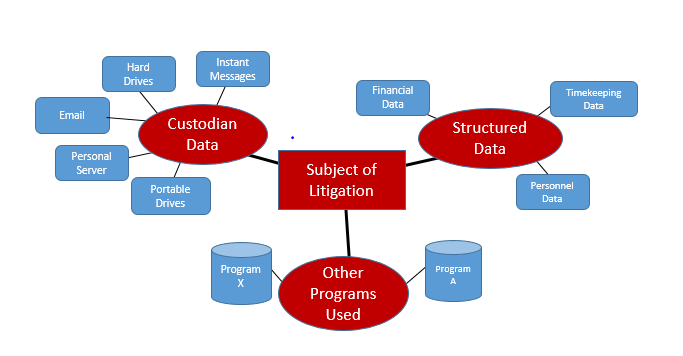Tips for Managing E-Discovery in a Large, Complex Litigation - Part One: Identification and Preservation of Data

This blog is part one of several regarding how to effectively and efficiently manage electronic discovery in large, complex litigation (we anticipate four parts but that could change over time). Between us, we have 25 years of litigation experience, ranging from very small matters with a few dozen documents to multi-billion dollar “bet the company” cases with thousands of custodians and multiple terabytes of data located throughout the world. It is in these large, complex matters that special attention to electronic discovery is crucial to the client’s overall success. We begin here with the earliest stages: data identification and preservation.
The Legal Hold
When litigation is threatened or a lawsuit is filed, the legal team’s “to do” list is long and the focus is often immediately on gathering facts and understanding the merits of the client’s claims or defenses. However, as early as possible (and ideally in the very first conversation), the legal team should make sure the client is thinking about their data as well, and specifically:
- What data might potentially be relevant;
- Where that data is located;
- Who is in charge of managing that data; and
- How to make sure it is preserved.
Ideally, our clients will already have internal policies and procedures in place to preserve data, but often they do not. Regardless of our clients’ sophistication when it comes to data retention, as legal counsel, we are tasked with ensuring our clients are taking whatever steps are necessary to preserve potentially relevant data.
1. Drafting the Legal Hold Notice
As part of that data preservation, it is important to work with the client’s internal legal team to develop a legal hold memorandum to send to any custodians that may possess data that is potentially relevant. Note here that we have used “may” and “potentially relevant” liberally. When it comes to data preservation, we prefer to be as thorough as possible, so any employee that might have data that might be relevant should be put on notice that they are under a legal obligation to preserve and not delete any of that data. Once you have a better understanding of where the relevant data is, it’s much easier to start narrowing the scope. Note that if any custodians or data reside internationally, there may be additional steps to take in advance of issuing a legal hold (such as notifying the individuals of their privacy rights).
In the legal hold memorandum, it is important to include enough detail to adequately identify both the potential scope and type of documents and data that must be preserved. In particular, the subject of the dispute or potential dispute should be clearly explained in terms that are understandable to custodians that may not have any legal background. Likewise, the term “document” should be explained in such a way to leave no ambiguity regarding what types of data and/or hard copies that the custodian and the client need to preserved.
After sending the hold notice, it is important to track acknowledgements and follow up with any custodians who do not respond to the hold. In large cases, we prefer to use an automated legal hold notification system that tracks acknowledgements and sends reminders automatically. We can also attach important documents to the hold and even include a questionnaire that will help us to target the data collection (more on the questionnaire below).
2. Implementing the Hold
Once the legal hold is issued, the data needs to actually be preserved. For this reason, in addition to individual custodians, the legal hold notice (or a similar notice drafted in a more technical manner) should also be sent to the internal IT team so that they can implement holds on the various data sources they manage and stop any auto-deletion practices that are in place.
Depending on the client’s capabilities, it may be necessary to work with them to develop a plan to implement the legal hold. To effectively implement the hold, it will be important to understand the client’s existing data retention policies for the data sources at issue. Some questions to consider include: What processes are in place to preserve an employee’s data when they leave the company? Is custodian email backed up, and if so, for how long? What archiving practices are in place? What data is saved on the cloud and what is saved on company or third party servers?
Just as legal hold acknowledgements should be tracked, data preservation should also be tracked. Legal teams may need to work closely with internal client IT representatives to track various data sources, the date on which the hold was implemented and whether any data is collected at the time of preservation.
Custodian Questionnaire and Interviews
We have found it helpful to attach to the legal hold notice a questionnaire that asks the custodian to provide specific information to assist the legal team with determining which custodians are key (or priority) custodians and identifying relevant sources of data. For example, the following are the types of questions that would potentially be helpful to include in the questionnaire:
- What is your current position with the company?
- During what period/s of time did you work on the [subject of litigation]?
- What was your title, position, or functional role on the [subject of litigation]?
- Do you save any documents related to the [subject of litigation] to any company or shared network locations? (Note that you may want to provide some examples of these types of locations, to the extent that the client has identified some examples.)
- Do you save any documents related to the [subject of litigation] to any personal locations (i.e. hard drive, network personal drive, external hard drives, etc.)?
- How do you organize and save your emails related to the [subject of litigation]?
- Do you have or maintain any hard copy documents related to the [subject of litigation]?
- Are there any locations not already listed in your responses above where you save documents related to the [subject of litigation]?
One added benefit of the questionnaire is that it may help limit the amount of data that needs to be collected. For example, if the subject of the litigation is a project that extended for five years, but the custodian was only assigned to that project for one year, you may be able to limit their data collection to a more narrow time period than other custodians, cutting down charges related to data processing, hosting, etc.
Of course, for the questionnaire process to work best, it is important to receive responses from each custodian involved. It’s very likely that some custodians will not respond, and follow-up requests for their response will be necessary. In addition, upon review of the responses, there may be some that are not entirely clear. You may need to follow up directly with those custodians to clarify their responses.
Once the custodian questionnaire responses are analyzed, you will likely want to conduct more thorough interviews with the key custodians, especially when discovery is phased with priority custodial data produced first and non-priority custodial data produced later on (if at all). The interview is a time where you can dive more deeply into the custodian’s role, insights that may be relevant to the litigation, and the location/narrowing down of the custodian’s data. During the interview, you can also explore must fully all the potential locations where the custodian’s team saved and shared their documents. This discussion will help provide details needed for the mapping exercise discussed in Section 3 below.
To the extent possible, it may be helpful to do a screenshare during the interview so the custodian can show any specific folders on their hard drive, archived folders in their email, or shared data sources where relevant documents are saved. If relevant documents are segregated in limited locations, you may be able to collect a smaller, targeted set of their data, again saving the client costs down the road.
Data Mapping
We have found it helpful to use the questionnaire, custodian interviews, and other discussions with the client to develop a mapping of the data sources relevant to the litigation. This map will assist both the attorneys and the client with confirming that all relevant data is preserved, as well as assist with the data collection process. Below is a basic sample data map:

Because a large litigation may have many more systems in play, this data map is just a start. However, you can see how this can provide a helpful visual for exactly what the client needs to preserve related to the litigation.
Of course, everything learned in the data identification and preservation process will greatly assist the legal team with the next step in the discovery process: data collection. Stay tuned for more information regarding data collection in the next blog post in this series.
DISCLAIMER: The information contained in this blog is not intended as legal advice or as an opinion on specific facts. For more information about these issues, please contact the author(s) of this blog or your existing LitSmart contact. The invitation to contact the author is not to be construed as a solicitation for legal work. Any new attorney/client relationship will be confirmed in writing.


